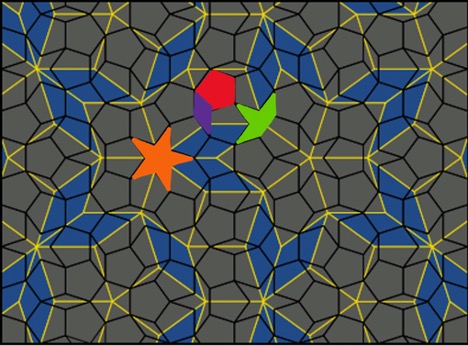| (2 intermediate revisions by one other user not shown) | |||
| Line 1: | Line 1: | ||
= First Penrose Tiling/Original Pentagonal Tiling (P1) = | = First Penrose Tiling/Original Pentagonal Tiling (P1) = | ||
| − | Roger Penrose started his formation of different types of tiling with the first Penrose tiling, commonly abbreviated as P1. In 1619, Johannes Kepler, a notable astronomer, wrote in his ''Harmonices Mundi'' that gaps in tiling that use regular polygons can only be filled with pentagrams, which are star polygons, decagons, and related shapes. As Penrose also observed, any attempt to tile a plane with regular pentagons will result in gaps. Penrose used Kepler's observation as inspiration, which leads to the types of shapes used in the first Penrose tiling: pentagons, stars (pentagrams), boats, and diamonds. In the image below, an example of a first Penrose tiling can be observed. Any proceeding terms can be visualized in the image. An example of a pentagon is shaded in red. An example of a star (pentagram) is shaded in orange. | + | Roger Penrose started his formation of different types of tiling with the first Penrose tiling, commonly abbreviated as P1. In 1619, Johannes Kepler, a notable astronomer, wrote in his ''Harmonices Mundi'' that gaps in tiling that use regular polygons can only be filled with pentagrams, which are star polygons, decagons, and related shapes. As Penrose also observed, any attempt to tile a plane with regular pentagons will result in gaps. Penrose used Kepler's observation as inspiration, which leads to the types of shapes used in the first Penrose tiling: pentagons, stars (pentagrams), boats, and diamonds. In the image below, an example of a first Penrose tiling can be observed (Wikipedia). Any proceeding terms can be visualized in the image. |
| + | *An example of a pentagon is shaded in <span style="color:red"> red</span>. | ||
| + | *An example of a star (pentagram) is shaded in <span style="color:orange"> orange</span>. | ||
| + | *A boat is essentially three-fifths of a star. An example of a boat is shaded in <span style="color:green"> green</span>. | ||
| + | *An example of a diamond is shaded in <span style="color:purple"> purple</span>. | ||
| + | For the first Penrose tiling, there are a total set of six prototiles, which are combinations of the different shapes that can be used without breaking the matching rules. | ||
<center> | <center> | ||
[[File:First_Penrose_Tiling_Example.jpeg|center|Example of First Penrose Tiling/Original Pentagonal Tiling (P1)]] | [[File:First_Penrose_Tiling_Example.jpeg|center|Example of First Penrose Tiling/Original Pentagonal Tiling (P1)]] | ||
| Line 6: | Line 11: | ||
[[Walther_MA271_Fall2020_topic27|Penrose Tiling Home]] | [[Walther_MA271_Fall2020_topic27|Penrose Tiling Home]] | ||
| + | |||
| + | [[MA271Fall2020Walther_Topic27_Concepts to Know Before Learning About Penrose Tiling|Previous Section: Concepts to Know Before Learning About Penrose Tiling]] | ||
[[MA271Fall2020Walther_Topic27_Second Penrose Tiling/Kite and Dart Tiling (P2)|Next Section: Second Penrose Tiling/Kite and Dart Tiling (P2)]] | [[MA271Fall2020Walther_Topic27_Second Penrose Tiling/Kite and Dart Tiling (P2)|Next Section: Second Penrose Tiling/Kite and Dart Tiling (P2)]] | ||
[[Category:MA271Fall2020Walther]] | [[Category:MA271Fall2020Walther]] | ||
Latest revision as of 01:56, 6 December 2020
First Penrose Tiling/Original Pentagonal Tiling (P1)
Roger Penrose started his formation of different types of tiling with the first Penrose tiling, commonly abbreviated as P1. In 1619, Johannes Kepler, a notable astronomer, wrote in his Harmonices Mundi that gaps in tiling that use regular polygons can only be filled with pentagrams, which are star polygons, decagons, and related shapes. As Penrose also observed, any attempt to tile a plane with regular pentagons will result in gaps. Penrose used Kepler's observation as inspiration, which leads to the types of shapes used in the first Penrose tiling: pentagons, stars (pentagrams), boats, and diamonds. In the image below, an example of a first Penrose tiling can be observed (Wikipedia). Any proceeding terms can be visualized in the image.
- An example of a pentagon is shaded in red.
- An example of a star (pentagram) is shaded in orange.
- A boat is essentially three-fifths of a star. An example of a boat is shaded in green.
- An example of a diamond is shaded in purple.
For the first Penrose tiling, there are a total set of six prototiles, which are combinations of the different shapes that can be used without breaking the matching rules.
Previous Section: Concepts to Know Before Learning About Penrose Tiling
Next Section: Second Penrose Tiling/Kite and Dart Tiling (P2)


